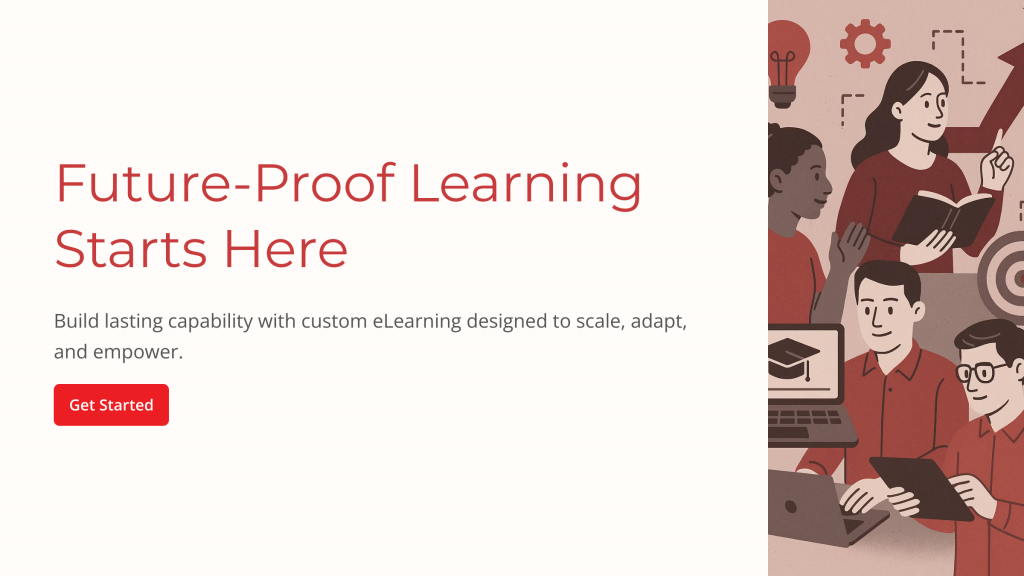
Organisations are navigating a convergence of disruption: emerging technologies, shifting workforce demographics, and evolving regulatory landscapes. The reality is that learning and development (L&D) is a strategic lever for resilience and growth.
Yet, many training strategies remain short-term, reactive, and focused on immediate compliance rather than sustainable capability.
Custom eLearning plays a pivotal role here. When designed with intent and foresight, it empowers learners with not just knowledge, but the confidence to navigate change and the tools to drive it.
What It Means to ‘Future-Proof’ Your L&D Strategy
To future-proof L&D is to design for durability, adaptability, and strategic alignment. It’s about preparing teams to thrive amid uncertainty. In a business environment defined by rapid transformation, future-proof L&D is proactive, learner-centred, and deeply integrated with organisational priorities.
This approach begins by looking beyond short-term upskilling. Future-proofing focuses on cultivating enduring capabilities (like critical thinking, systems awareness, digital dexterity, and leadership resilience) that empower learners to grow with the business, not just within it.
A future-ready L&D strategy also acknowledges that learning is not a one-off event. It’s an evolving journey. Programmes must be built to scale, adapt, and remain relevant over time. That means modular content, context-aware learning pathways, and systems that support continuous feedback and improvement.
The Strategic Role of Custom eLearning
Unlike standardised courses, custom-designed solutions are built around the unique needs, goals, and culture of each organisation. This alignment ensures that learning isn’t just relevant: it’s strategic.
When learning initiatives reflect real-world challenges and operational contexts, they resonate more deeply. Employees engage with content that mirrors their day-to-day experiences, equipping them to apply knowledge immediately and effectively. The result is faster skill adoption and stronger organisational capability.
Custom eLearning also supports strategic initiatives such as digital transformation, safety compliance, and leadership development. It can address region-specific regulations, sector-specific risks, and internal processes, ensuring that learning supports operational priorities.
Moreover, this approach enables long-term value. Programmes can evolve with business needs, using data-driven insights to refine and scale content over time. This adaptability is essential for organisations committed to building a learning culture that fuels innovation, accountability, and resilience.
Designing for Longevity: What Makes eLearning Sustainable
Sustainable eLearning remains relevant and impactful as organisational needs evolve. Achieving this kind of longevity requires intentional design choices that prioritise flexibility, relevance, and learner engagement from the outset.
One key principle is modularity. By structuring content in self-contained units, organisations can easily update or reconfigure learning paths without overhauling entire programmes. This makes it easier to respond to shifting priorities, new technologies, or changes in regulations.
Another factor is contextual adaptability. Sustainable eLearning reflects the real-world environments in which learners operate. It incorporates role-specific scenarios, dynamic branching, and challenge-based activities that remain applicable even as roles expand or systems evolve.
User-centred design also plays a vital role. When content is created with diverse learner needs in mind (from accessibility to different learning styles) it fosters deeper engagement and knowledge retention. This ensures the learning journey continues to deliver outcomes long after initial rollout.
A critical advantage of sustainable design is learning scalability. By developing content that can be deployed across locations, roles, and devices without compromising quality, organisations can support consistent capability building at scale: efficiently and cost-effectively.
Finally, integrating learning platforms with organisational systems (like LMSs, performance dashboards, or knowledge bases) creates a continuous feedback loop. It allows content to evolve in sync with business performance data, ensuring learning remains aligned with strategic goals.
Let’s Build Something That Lasts
Long-term capability doesn’t happen by accident; it’s the result of intentional design, strategic alignment, and meaningful collaboration. If your organisation is ready to move beyond one-off training solutions and invest in learning that adapts, scales, and delivers lasting impact, now is the time to act.
Anderson Studios partners with forward-thinking L&D leaders to create custom eLearning solutions that grow with your business and empower your people. Every project begins with a conversation: an opportunity to explore your challenges, goals, and the capabilities you want to cultivate for the future.
Let’s create something that endures. Reach out to Anderson Studios to start building a learning ecosystem that drives progress today and supports sustainable success tomorrow.

